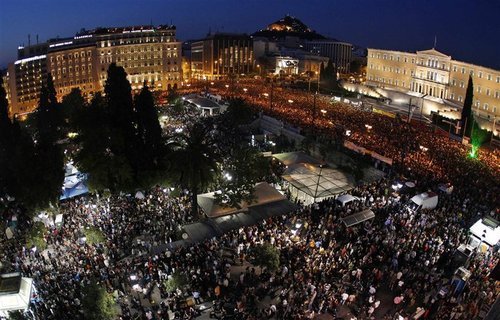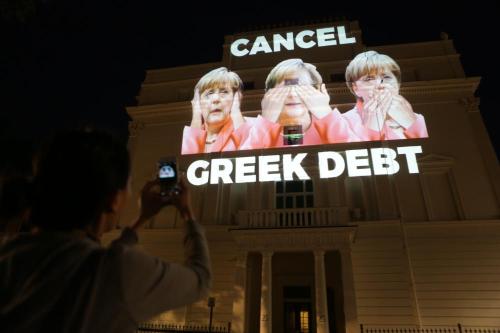#austerity
InTowards a New Architecture, Le Corbusier expresses his fanboyism for the Parthenon as an object of modernity, admiring its “audacity for square mouldings”, “austere profiles” and “doric morality”.
Post link
HOMILY for Fra Angelico
James 2:14-24. 26; Ps 111; Mark 8:34-9:1

The words of St James, his injunctions about care and love for the poor would have resonated in the heart and actions of today’s Dominican blessed. For although he is renowned as a painter and indeed is regarded as the patron saint of artists, Blessed John of Fiesole’s own epitaph, carved around his tomb in the church of Santa Maria sopra Minerva in the centre of Rome says: “When singing my praise, don’t liken my talents to those of Apelles. Say, rather, that, in the name of Christ, I gave all I had to the poor. The deeds that count on Earth are not the ones that count in Heaven. I, Giovanni, am the flower of Tuscany.” So, it is fitting on his feast day to remember that Blessed John did not want so much to be remembered for his artistic talents as for his charity, his love of the poor, his unseen deeds which honour Christ on earth in the poor and needy, and which thus redound to his glory in heaven. For as Christ warns in the Gospel today: “What gain, then, is it for a man to win the whole world and ruin his life?” No, it is better to strive for treasure and beauty in heaven through good deeds on earth, as St James says.
And yet this is a side of Blessed John that is often neglected: the aspects which account for his sanctity and his reputation in his lifetime that led to him being called Fra Angelico, the angelic friar. It’s often forgotten, even by Dominicans, that Blessed John was a pious layman and professional painter before he joined the Order; that he had joined a Confraternity that believed in physical asceticisms and discipline; that he was deeply influenced by the teachings and writings on social justice and economic reform advanced by the Dominican Archbishop of Florence, St Antoninus; and that in 1420 he joined the Observant branch of the Dominicans at Fiesole, who were engaged in acts of corporal mortification, severe fasting and asceticism, prayer and study by day and throughout the night, and a strong commitment to poverty. Fra Angelico would become the Prior of St Dominic’s Priory in Fiesole, a convent nestled in the secluded Tuscan hills near Florence, where he painted many altarpieces.
In 1439, St Antoninus, who was then Prior of St Mark’s in Florence, asked Fra Angelico to come to Florence and to paint frescoes of the Passion of Christ and of various Mysteries of the Rosary in the rooms of the friars. Whereas earlier theologians and ascetics had dismissed art and beauty as frivolous or a distraction from prayer and study, St Antoninus affirmed the importance of art in moving souls to devotion, and as an aid to prayer, focusing the mind on sacred things, and helping us to contemplate the higher things of God. Undoubtedly, St Antoninus’s view on sacred aesthetics was a great encouragement to Fra Angelico, and the beautiful convent of San Marco in Florence, which is now a museum of Fra Angelico’s art, is a testimony to the power of sacred art to inspire prayer and devotion. Hence, Dominican churches such as this one, which is full of sacred art especially in our Rosary Chapels, follow the insights of St Antoninus and Blessed John, which is that art and beauty lead us to contemplate divine mysteries with greater efficacy.
Thus many of the friars’ rooms in Florence are painted with images of the Cross and Passion of Christ, inviting them to meditate on the love of the suffering Christ. The words of today’s Gospel would have resonated in the minds of the friars who studied and prayed in those cells: “If anyone wants to be a follower of mine, let him renounce himself and take up his cross and follow me”. Indeed Fra Angelico painted many images of the Crucifixion with St Dominic or a friar clinging to the cross.
However, it is Fra Angelico’s depictions of Our Lady, especially his paintings of the Annunciation, which are probably his most luminous works. A divine light suffuses his paintings, which in their beauty and serenity are the fruit of Blessed John’s contemplation; they are painted sermons which endure and continue to inspire us long after the homilies of contemporary preachers have faded from memory. For as Pope St John Paul II said: “Angelico was reported to have said: ‘He who does Christ’s work must stay with Christ always.’ This motto earned him the epithet ‘Blessed Angelico,’ because of the perfect integrity of his life and the almost divine beauty of the images he painted.”
So today, as we honour Blessed John of Fiesole, we recall not only his art but also his words, his teaching, his inspirations, and the beauty of his life – beautiful because of its integrity and authenticity as a Dominican friar preacher; beautiful because he so closely followed and contemplated Christ and Our Lady; and beautiful because his life shone with good works. May he pray for us, that our lives may also reflect the beauty of holiness.
May Day in Puerto Rico: Police Attack Anti-Austerity Protesters with Pepper Spray & Tear Gas
Thousands of Puerto Ricans marked May Day by joining a general strike in the capital of San Juan to protest austerity measures, from the closing of public schools to increases in university tuition. When protesters tried to converge on the building where the federal financial oversight board has its offices, police fired tear gas and pepper spray.
Protester Raina Ramírez, a chemistry student, described the violence:
“The police surrounded us. They blocked us from each side, and they didn’t let us through. They began throwing tear gas at us, and I couldn’t get out. I have asthma. And with that and running away, my asthma situation became more difficult.“
Watch the full report from the streets of San Juan.
Post link





Arise (2013) by Jason Kearney
18-01-2105, 101 years on from the day the Dublin Lock-out ended, the people of Ireland still face a struggle. Has much changed? A day of mass civil disobedience is planned for January 31st, with local protest groups from all over Ireland coming together on the streets of Dublin to voice their anger at Irish Water, to oppose the water metres in an age of ongoing austerity.
Post link

What was a movement became a party and got elected to power.
These are indeed strange times in Greece. The land that birthed the word democracy also produced the word tyranny. With the election of Syriza, the Radical Coalition of the Left, the Greek people stand poised to pit those ancient foes against one another, in a battle that will have tremendous consequences for the people of the small republic and others throughout economically-troubled southern Europe.
Five years ago, in May of 2010, a protest movement took Syntagma Square in Athens. In modern Greek, Syntagma is translated as “constitution,” but in Ancient Greek it means “to arrange together.” And so, in this aptly-named place, a constellation of unionists, leftists, communists, anarchists, and students responded to many factors, but most immediately to cuts in social expenditures and tax increases, by taking to the streets. The world took notice.
Protests continued in Athens, Thessaloniki, and other cities. A year later the movement, now referred to as the Indignants at Syntagma, established general assemblies. As Germany’s Angela Merkel called on Greece to tighten the fiscal screws in return for renewed loan terms, the protests grew, as did violent repression. The activists called for corrupt politicians to be charged, refusal of odious debt, and a new constitution. The Indignants’ demands were not met, but they launched inequality, corruption, and anti-austerity into the public discourse. Tremendous marches lent a sense of credibility to the movement; estimates of attendance at these public displays ranged from 100,000 to 500,000.
Despite public pressure to reject austerity and excitement surrounding a scheduled referendum, the Papandreou government of PASOK (socialists in name alone) stood down and the so-called bailouts were accepted. The referendum was cancelled and Greece would be driven into a period of austerity. The neoconservative Samaras government of New Democracy, would continue dosing the Greek nation with the Troika’s prescription of debt payments, increased taxation, and extreme decreases in social spending.
The tyranny of neoliberal capitalism and austerity ravaged the tiny Mediterranean country of Greece against the democratic will of the people.Social and human rights costs have been high, the country’s healthcare system gutted, public lands stripped, and utilities and services privatized. In recent years, youth unemployment soared to 50%andpoverty has hit a critical threshold, devastating the lives of much of the populace.
As social safety nets fell, Greeks relied on community and family to keep them from absolute destitution. Many were unfortunate, and suicide rates skyrocketed. None was more traumatic to the national psyche than that of Dimitris Christoulas, a 77-year-old retired pharmacist and fixture at the rallies, who took to Syntagma Square and shot himself in the head. His suicide note lamented, “I see no other solution than this dignified end to my life, so I don’t find myself fishing through garbage cans for my sustenance. I believe that young people with no future, will one day take up arms and hang the traitors of this country at Syntagma square, just like the Italians did to Mussolini in 1945.″
Syriza became electable because of circumstances like these. New Democracy may have been in power these last four years, but it was the centrist PASOK government that cancelled a referendum on the bailout, a referendum which polls showed would go decisively in the favor of rejecting the bailout terms.
When the 2015 elections arrived, Syriza, a party born out of the discontent in Syntagma, ascended to the government of Greece with a strong but not dominant mandate. Their victory has been met with extreme optimism in some circles and outright hysteria in others.
When it comes to governance, it would be an understatement to say things are complicated for Syriza. Falling two seats short in the election of a complete majority and spurned by the orthodox and principled communist party, KKE, Syriza had to turn elsewhere to form a coalition government.
To the utter dismay of many in their base, they came to terms with ANEL (Greek Independents), a party of extreme conservativism. Many of its members are originally from the party of the outgoing government. They disagree with Syriza about everything with the exception of the need to do away with Austerity. Kammenos, the party leader, recently named Defence Minister, is known as a hawkish nationalist with strong ties to the Greek oligarchy. His openly racist and homophobic stance are troubling to Syriza’s base and spell a capitulation on their progressive stance on issues like rights for same-sex couples and the demilitarization of the police.
What does this willingness to compromise with ideological opposites tell us about Syriza?
It tells us that Syriza obviously places repudiating austerity as a priority. While formed of composites from other Leftist parties, Syriza is not a homogenous party of class struggle, it appears to be the party of anti-Austerity. What started as a party of social movement is today a party of government.
On the financial side of things, Syriza has been very clear. They’ve backed away from leaving the EU and as now-Prime Minister Tsipras and recently named Finance Minister Varoufakis have explained, they intend to drastically negotiate the terms of the debt, to return the minimum wage to pre-crisis levels, and to stop the privatization of utilities and public land.
Varoufakis, the economics professor turned finance minister, has been an ardent critic of austerity, the European Union and power-wielding, tax-dodging Greek oligarchs for years. He recently referred to the debt peonage and austerity measures as “fiscal waterboarding.”
For those far to the left, this is quite a disappointment as it departs from Syriza’s rhetoric of two years ago, which was a more radical agenda to expunge the debt and leave the EU. Still, facing Greece’s creditors, negotiating the debt and remaining in the EU will be no easy feat.
The Troika, fearing the implications that even partial debt forgiveness would have on other indebted countries, has expressed great disapproval of any renegotiations, even as austerity crushes the Greek people.
In Syriza’s arsenal of economists, Varoufakis may be the most prestigious, but not the most radical. He’s a trained economist, an expert on game-theory, a self-proclaimed Marxist Libertarian and a former advisor-turned-critic of the Papandreou government that led Greece into the so-called bailout. In addition to challenging the Troika, Varoufakis intends to take on the Greek oligarchs, in a television interview he recently said “we are going to destroy the basis upon which they have built for decade after decade a system and network which viciously sucks the energy and economic power from everyone else in society.”
With the government’s economic and financial stance clear, what are we to make of Syriza on the social front? What of the immigrants dying in the streets at the hands of nationalist thugs? What of the gay rights promised by Syriza? What of demilitarization? In keeping with the platform, Tsipras appointed a cabinet of academics and “human rights advocates.” But the coalition with ANEL will put a strain on these commitments. If Syriza cannot deliver on these issues, what is one to make of all the promises jeopardized by the capitulation to conservatives? These too are pressing questions.
Orthodox communists will bemoan Syriza and Tsipras; to many he is already a champagne socialist. Conservatives and reactionaries have already began ridiculing the party’s hopes as Leftist pipe-dreams.
Syriza now has to govern, they are the party of government — not of revolution. The euphoria of the election was quickly tempered by the pragmatism of governance and the task at hand. They have yet to propose anything radical, instead they talk of minimum wage, eased debt payments, and social programs. These are important programs that may improve social conditions for many in Greece. There is no program of mass nationalizations or land appropriations. If one is looking for a party that will sweep away the state into a classless society, he is looking in the wrong place.
In forming a coalition with ANEL, Tsipras is perhaps hearkening the advice of J.K. Galbraith when he told President Kennedy, “(p)olitics is not the art of the possible. It consists in choosing between the disastrous and the unpalatable.” Tsipras must determine if governance is more palatable than principle.
To forego the unpalatable, to take any kind of leap to the possible, Syriza needs to display a stronger mandate than it earned in the elections.
Here it’s instructive that the Greeks remember their history. They last faced tyranny during the period of the military junta of 1967-1974. It was the student-led uprising at Athens Polytechnic that notably defied the dictatorship. The uprising was not itself successful at restoring democracy, but many believe it precipitated the falling of the dictatorship nine months later.
We return now to the beginning. What Syriza, and more importantly Greece, needs is the continuation of social movements. What Greece and maybe Europe needs is Syntagma.
photocredit: KotsolisatEnglish Wikipedia
Previously published in CounterPunch.
Christoffer Wilhelm Eckersberg, Last Supper, 1839–40.
Oil on canvas.
Frederiksberg Church, Copenhagen.
Post link
In Ontario, disability (ODSP) payments are so far below the poverty line that people on disability are seeking out medical assistance in death (MAID). The only thing our premier has to say about it is that disabled people should just work if they wanna get out of poverty so bad.
Ewald’s payments total $1,169 per month to cover rent, food, and other essentials. He tells CityNews he will apply for MAID if his situation gets worse and knows several others who are doing the same.“I’m not suicidal. Sometimes it’s a choice between burning to death and jumping out of a high-rise building. I’d like to have that choice. I’ve suffered. I really don’t want to suffer past a certain point,” said Ewald. “I wouldn’t be doing it if I wasn’t so stuck in this situation with ODSP.”[…] He tells CityNews he survives, as many do, by learning the “ODSP diet.” For some, it’s not much more than a potato a day, while others drink coffee because caffeine is an appetite suppressant.[…] “For the people who are unable to work, for any reason, be it physically, mentally, I will always be there to support them,” said Ford. “But the people who can work in any capacity at all, there’s endless jobs in every sector and the best way to help someone who can work is to get them a job.”[…] The Ontario NDP and The Green Party of Ontario have promised to raise rates if elected this June, while the Liberals have yet to make an announcement on the issue.Aside from being callous ableist bullshit, Ford’s response ignores that:
- getting approved for ODSP is a NOTORIOUSLY gruelling and difficult process - there are far too many people with serious and documented disabilities that STILL can’t get ODSP, so this alleged “issue” of “people who could work but are on ODSP instead” is extra-ridiculous
- if he’s implying that people should be working while receiving ODSP - YOUR SUPPORT IS REDUCED IF YOU MAKE TOO MUCH MONEY! Even if you are able to work a LITTLE (although if you got approved you probably aren’t, see previous point), anything over a very low threshold (around $200 per month as per the link below) is going to reduce your ODSP payments. The extra amount you could earn is absolutely not enough to lift ODSP recipients out of poverty.
Can I work and get ODSP at the same time? - Steps to Justice
God, he’s a piece of shit.














